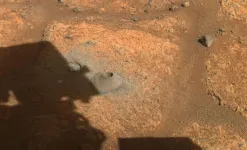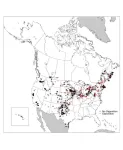(Press-News.org) Images
EAST LANSING, Mich. – The U.S. Department of Energy Office of Science, or DOE-SC, has awarded $115 million for the High Rigidity Spectrometer, or HRS, project at the Facility for Rare Isotope Beams, or FRIB, at Michigan State University.
The HRS instrument will enable scientists to characterize the properties of isotopes that are created in rare-isotope reactions produced at about 50% of the speed of light. With the ability to measure properties such as the mass, charge and velocity of rare isotopes produced in those conditions, HRS will be a centerpiece experimental instrument of FRIB’s fast-beam program that will substantially increase FRIB’s scientific reach and productivity.
Supporting a user community of over 500 scientists planning to use HRS, the new cooperative agreement provides $115,306,881 over seven years to establish and operate HRS. The 2015 Nuclear Science Advisory Committee Long Range Plan identified HRS as a key instrument for FRIB.
The HRS cooperative agreement is in addition to the recently awarded FRIB cooperative agreement supporting FRIB operations. The DOE-SC awarded $529 million over five years to operate FRIB as a DOE-SC user facility to enable unprecedented discovery opportunities envisioned by a user community of 1,800 scientists, supporting the mission of the DOE-SC Office of Nuclear Physics. HRS serves about one-fourth of those users.
With near 100% efficiency, HRS will transmit isotopes that are travelling at velocities for which the rare-isotope production rate is optimal. In addition, at the higher velocities, the foils in the rare-isotope production target — in which reactions between isotopes take place — can be much thicker, greatly increasing the chances that a desired isotope reaction will occur. The combined effects of a higher rare-isotope beam intensity and the use of thicker target foils will greatly increase the sensitivity of the scientific program at FRIB.
HRS will thus extend FRIB’s scientific reach to neutron-rich isotopes by up to a factor of more than 100. This will be beneficial, particularly for experiments with the most neutron-rich isotopes that have the highest potential for discovery. The increase will enable experiments not otherwise possible anywhere in the world, such as detailed studies of calcium-60. Calcium-60 has 12 more neutrons than the heaviest stable isotope of calcium found in nature. It is of particular interest to understand the forces that bind neutrons and protons into nuclei.
HRS is designed to eventually accommodate FRIB’s scientific program after the envisioned FRIB400 energy upgrade that will double FRIB’s beam energy to 400 MeV/nucleon and expand the scientific impact by increasing the yield of many rare isotopes tenfold.
Because of the wide variety of experiments that can be performed with HRS, a large, multi-institutional team of scientists collaborates to develop the scientific case and conceptual design for HRS. The FRIB Users Organization HRS working group meets regularly. Members include:
Twenty U.S. universities and colleges: Augustana College, Bucknell University, Central Michigan University, Davidson College, Florida State University, Hope College, Indiana University, Indiana Wesleyan University, Kalamazoo College, Michigan State University, Ohio University, Ohio Wesleyan University, Rutgers University, Texas A&M University, University of North Carolina/TUNL, University of Notre Dame, University of Tennessee, Washington University in St. Louis, Ursinus College and Wabash College
Five U.S. national laboratories: Argonne National Laboratory, Lawrence Berkeley National Laboratory, Los Alamos National Laboratory, Lawrence Livermore National Laboratory and Oak Ridge National Laboratory
Four international institutions: GSI/FAIR (Germany), Radioactive Isotope Beam Factory (RIBF) at RIKEN (Japan), TRIUMF (Canada) and University of Surrey (England)
FRIB serves a global user community
FRIB enables scientists to make discoveries about the properties of rare isotopes, nuclear astrophysics, fundamental interactions and applications for society, including in medicine, homeland security and industry, through research with fast, stopped and reaccelerated rare isotope beams.
FRIB provides researchers with a vast unexplored terrain of more than 1,000 new rare isotopes never before produced — more than double what was previously possible.
Since the start of user operation in May 2022, FRIB has delivered more than 210 rare isotope beams to experiments and supported 665 participants, including 177 students, across 50 countries and 189 institutions (including U.S. national laboratories, colleges and universities).
FRIB’s scientific user community — 1,800 scientists from 124 U.S. colleges and universities, 13 national laboratories and 52 countries — is composed of scientists, postdoctoral research associates and graduate students. The community continues to develop new instruments and concepts to optimize FRIB’s discovery potential, based on new scientific insights.
“This new award enables us to design and establish a new instrument at FRIB, which substantially increases FRIB’s scientific impact, in support of a large, multi-institutional user community of more than 500 scientists planning to use HRS in their forefront research,” said FRIB Laboratory Director Thomas Glasmacher. “We are so thankful for the continued trust the U.S. Department of Energy Office of Science, our Michigan Congressional delegation and MSU have placed in FRIB to forward the nation’s rare-isotope research capabilities.”
The HRS and FRIB cooperative agreements are in addition to 30 other funding agreements administered by FRIB faculty members supporting research at FRIB.
Read on MSUToday.
###
Michigan State University has been advancing the common good with uncommon will for more than 165 years. One of the world's leading research universities, MSU pushes the boundaries of discovery to make a better, safer, healthier world for all while providing life-changing opportunities to a diverse and inclusive academic community through more than 400 programs of study in 17 degree-granting colleges.
Michigan State University (MSU) operates the Facility for Rare Isotope Beams (FRIB) as a user facility for the U.S. Department of Energy Office of Science (DOE-SC), supporting the mission of the DOE-SC Office of Nuclear Physics. User facility operation is supported by the DOE-SC Office of Nuclear Physics as one of 28 DOE-SC user facilities.
The U.S. Department of Energy Office of Science is the single largest supporter of basic research in the physical sciences in the United States and is working to address some of today’s most pressing challenges. For more information, visit energy.gov/science.
For MSU news on the Web, go to MSUToday. Follow MSU News on Twitter at twitter.com/MSUnews.
END
US Department of Energy Office of Science awards $115M for High Rigidity Spectrometer project at FRIB
2023-09-25
ELSE PRESS RELEASES FROM THIS DATE:
Algorithm would predict disease relapses
2023-09-25
A University of Texas at Arlington research team has received a $450,000 grant from the National Institute of General Medical Sciences to use statistical machine learning to review patient data and better predict which patients will need additional treatments.
“With recent advances in screening, diagnosis and treatment, many diseases like cancer or cardiovascular disease can be identified in an early stage,” said Suvra Pal, associate professor of statistics in the Department of Mathematics. “Fortunately, a significant proportion of patients living ...
Exercise-mimicking drug sheds weight, boosts muscle activity in mice
2023-09-25
A brand-new kind of drug, tested in mice, shows promising new results that could lead to the development of a new weight-loss drug that mimics exercise.
The new compound, developed and tested by a University of Florida professor of pharmacy and his colleagues, leads obese mice to lose weight by convincing the body’s muscles that they are exercising more than they really are, boosting the animals’ metabolism.
It also increases endurance, helping mice run nearly 50% further than they could before. All without the mice lifting ...
Did life exist on Mars? Other planets? With AI's help, we may know soon
2023-09-25
Scientists have discovered a simple and reliable test for signs of past or present life on other planets – “the holy grail of astrobiology.”
In the journal Proceedings of the National Academy of Sciences, a seven-member team, funded by the John Templeton Foundation and led by Jim Cleaves and Robert Hazen of the Carnegie Institution for Science, reports that, with 90% accuracy, their artificial intelligence-based method distinguished modern and ancient biological samples from those of abiotic origin.
“This routine analytical method has the potential to revolutionize ...
Wind energy projects in North America are more likely to be opposed by white, wealthy communities
2023-09-25
(Santa Barbara, Calif.) — Wind energy is, by far, the most common type of clean energy. And transitioning to clean energy is critical to addressing the climate crisis. Yet local opposition poses a significant barrier to the deployment of wind energy projects.
A study published in Proceedings of the National Academy of Sciences (PNAS) by researchers from UC Santa Barbara, the University of Michigan and Gallup Inc. examined wind energy projects throughout the United States and Canada to determine how common opposition is and what factors predict it. The study found that nearly one in five projects faced opposition ...
Naming and shaming can be effective to get countries to act on climate
2023-09-25
Enforcement is one of the biggest challenges to international cooperation on mitigating climate change in the Paris Agreement. The agreement has no formal enforcement mechanism; instead, it is designed to be transparent so countries that fail to meet their obligations will be named and thus shamed into changing behavior. A new study from the University of California San Diego's School of Global Policy and Strategy shows that this naming-and-shaming mechanism can be an effective incentive for many countries to uphold their pledges ...
Scientists develop method of identifying life on other worlds
2023-09-25
Humankind is looking for life on other planets, but how will we recognise it when we see it? Now a group of US scientists have developed an artificial-intelligence-based system which gives 90% accuracy in discovering signs of life.
The work was presented to scientists for the first time at the Goldschmidt Geochemistry Conference in Lyon on Friday 14th July, where it received a positive reception from others working in the field. The details have now been published in the peer-reviewed journal PNAS (see notes for details).
Lead researcher Professor Robert Hazen, of the Carnegie Institution’s Geophysical ...
Caribbean parrots thought to be endemic are actually relicts of millennial-scale extinction
2023-09-25
In a new study published in PNAS, researchers have extracted the first ancient DNA from Caribbean parrots, which they compared with genetic sequences from modern birds. Working with fossils and archaeological specimens, they showed that two species thought to be endemic to particular islands were once more widespread and diverse. The results help explain how parrots rapidly became the world’s most endangered group of birds, with 28% of all species considered to be threatened. This is especially true for parrots that inhabit islands.
On ...
CSIC contributes to deciphering the enigmatic global distribution of fairy circles
2023-09-25
One of the most impressive and mysterious natural formations that we can observe in the arid areas of our planet are the fairy circles. These are enigmatic circular patterns of bare soil surrounded by plants generating rings of vegetation, which until now had only been described in Namibia and Australia. Over the years, multiple hypotheses have been proposed to explain their formation, which have given rise to numerous discussions about the mechanisms that give rise to them. However, until now, we did not know the global dimension of this type of phenomena and the environmental ...
Insilico Medicine and University of Cambridge present new approach to discover targets for Alzheimer’s and other diseases with protein phase separation
2023-09-25
New York and Cambridge, UK -- Recent research demonstrates that protein phase separation (PPS) is widely present in cells and drives a variety of important biological functions. Protein phase separation at the wrong place or time could create clogs or aggregates of molecules linked to neurodegenerative diseases like Alzheimer’s and Parkinson’s, and poorly formed cellular condensates could contribute to cancers and might help explain the aging process.
Given the emerging association between human disease and the PPS process, scientists have been looking for ways to identify potential targets for therapeutic interventions based on PPS regulation. Today, Insilico ...
Antibiotics can help some bacteria survive for longer
2023-09-25
Scientists have found a surprising effect of some antibiotics on certain bacteria – that the drugs can sometimes benefit bacteria, helping them live longer.
Until now, it has been widely acknowledged that antibiotics kill bacteria or stop them growing, making them widely used as blanket medication for bacterial infections. In recent years, the rise of antibiotic resistance has stopped some antibiotics from working, meaning that untreatable infections could be the biggest global cause of death by 2050.
Now, researchers at the University of Exeter have shown for the first time that antibiotics ...






